 |
|
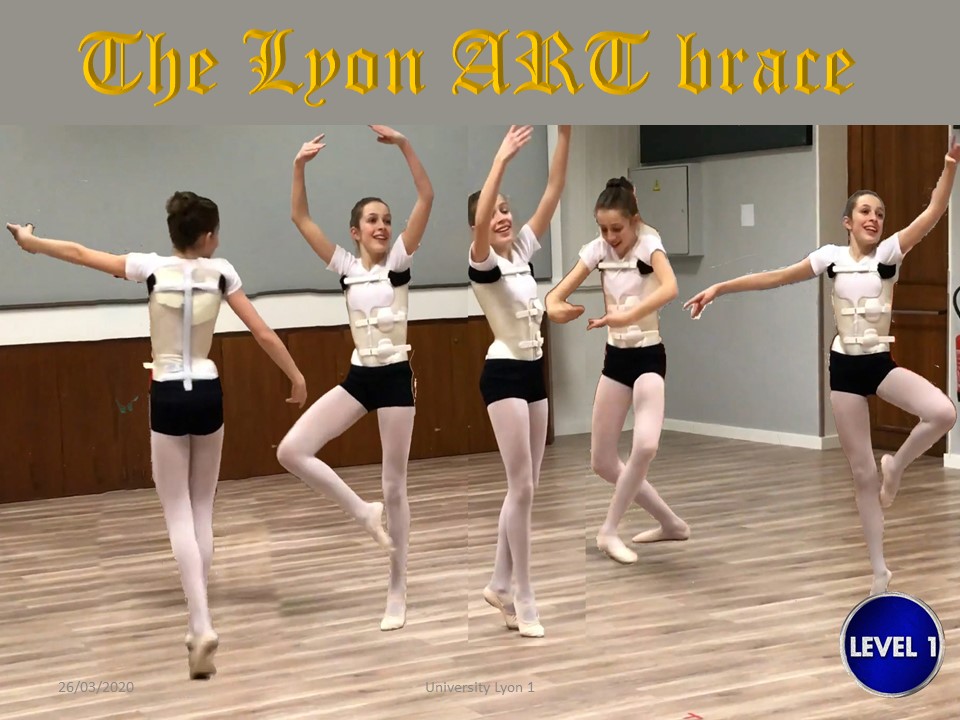 |
The Lyon brace, heir to a long tradition of nearly 200 years, was the first adjustable “under-arm” brace made of leather-steel, 70 years ago. It followed a reductive plaster cast and was intended to maintain this reduction. Leather has been replaced by high-rigidity polymethacrylate and more recently by polycarbonate which replaces the plaster cast, as demonstrated by Negrini.
|
 |
The diversity of modern braces complicates their use. This is why, before studying the specificities of the Lyon brace, it is important to specify the main objectives of scoliosis bracing, which leads to the choice of the brace and allows to better understand the reasons for the diversity.
|
 |
All braces guide growth overnight. Some nocturnal hypercorrective braces allow the centering of the nucleus at the level of the apical vertebra. The Lyon method with plastercast or total time wearing of the hypercorrective ARTbrace achieves an adjustment of tensions or plastic deformation in the corrected posture. To reverse the deformation of the apical vertebra, an average in-brace correction of more than 48% is necessary, which usually requires an asymmetric brace. Symmetrical braces with maximum contact surface at the level of the trunk generally reduce the load at the level of the vertebral axis. ARTbrace is a compromise with controlled hypercorrective asymmetry, that is to say with the maximum contact surface.
|
 |
This protocol is used for example in congenital scoliosis and many publications highlight bone remodeling. It is also effective in idiopathic scoliosis until early pubertal growth. However, care should be taken to use braces that do not limit the growth of the rib cage.
|
 |
Discal scoliosis has 3 aspects: 1. Histological alteration of the intervertebral disc with decrease in elastin fibers. 2. disc asymmetry that explains part of the Cobb angulation. 3. Expulsion of the nucleus of the intervertebral disc towards the convexity. Histological alteration of intervertebral discs is conventional in scoliosis, but it is difficult to determine whether this is a cause or a consequence.
|
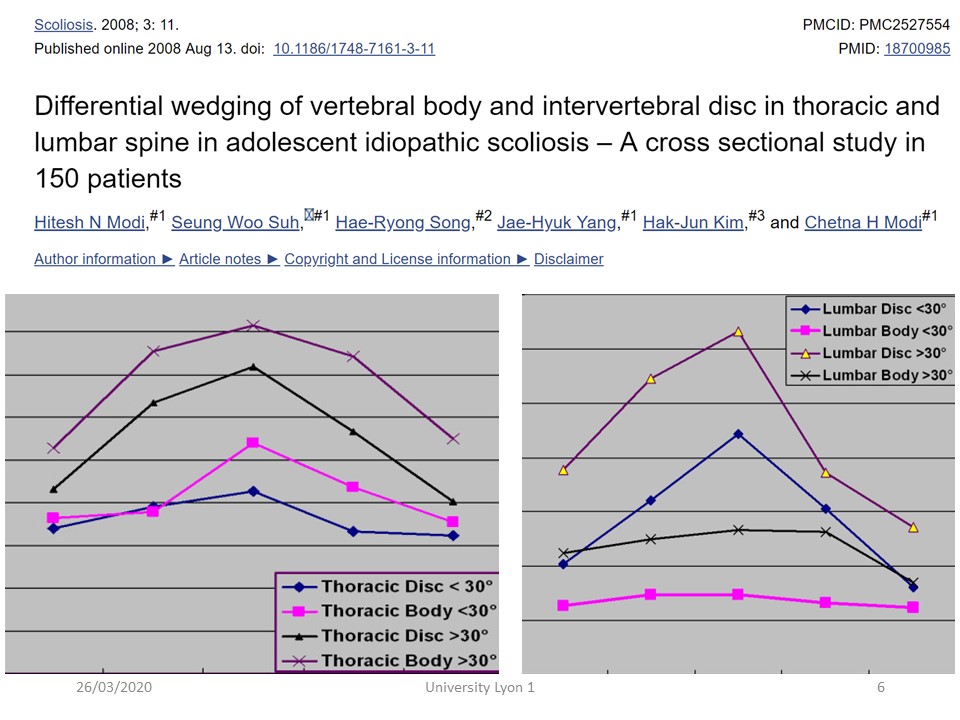 |
Radiologically, there is a disc asymmetry predominant at the lumbar level and one can speak of intervertebral disc scoliosis.
|
 |
The nucleus of the intervertebral disc is pushed towards the convexity, which can explain some difficulties of reduction. This is the main mechanism of action of night hyper correcting braces.
|
 |
Until now hyper-correcting braces could be used only at night. The ARTbrace is the only hyper-corrective full time brace.
|
 |
In these cases of hyper-correction, we can hope for total correction of Cobb angle. This girl was treated at Risser 2 and the correction being quite total after 6 months, a weaning test was carried out.
|
 |
Growth occurs in the growth cartilage of the bone. It is braked by ligaments and paravertebral fasciae. The asymmetry of the paravertebral chains explains the very high progression of scoliosis in the pubertal period. Beyond the elastic deformation, creep or plastic deformation is obtained either by increasing traction, which would not be supported by the child, or by a prolongation in time of the corrective traction, this is what was achieved by the plastered cast or the "total time" brace wearing. A tensile stress is a stress that tends to stretch or lengthen the material. Strain is defined as "deformation of a solid due to stress“, the structure does not return to its initial size and its original shape after removal of applied loads. It's a plastic permanent behavior or creep, after exceeding the elastic limit.
|
  |
Stretching the concavity requires a hyper-corrective brace, so braces correcting to less than 20% are considered ineffective.
|
 |
Creep is the physical phenomenon that causes the irreversible deformation of a material subjected to a constant stress (denoted σ0) for a sufficient period of time. A ligament is under tension under a certain stress. The soft tissue stretches quickly initially, then continues to stretch more slowly. When a constant directional stress is exerted with a plaster cast, it causes a flow of the soft tissues in the appropriate direction. After 3 weeks, collagen fibers are progressively aligned to conform to the original structure. Clinically, about 4 weeks of immobilization are necessary.
|
 |
All symmetrical braces have a maximum contact area with the trunk and reduce the load on the vertebral body by composite beam effect. On the contrary, very asymmetrical braces with large expansions and limited contact area do not reduce mechanical stress. That's why ARTbrace is a brace with controlled asymmetry.
|
 |
In addition to bone fragility during growth, there is also osteopenia linked to scoliosis. It causes in women a decrease in the number of trabeculae and in men a thinning of trabeculae.
|
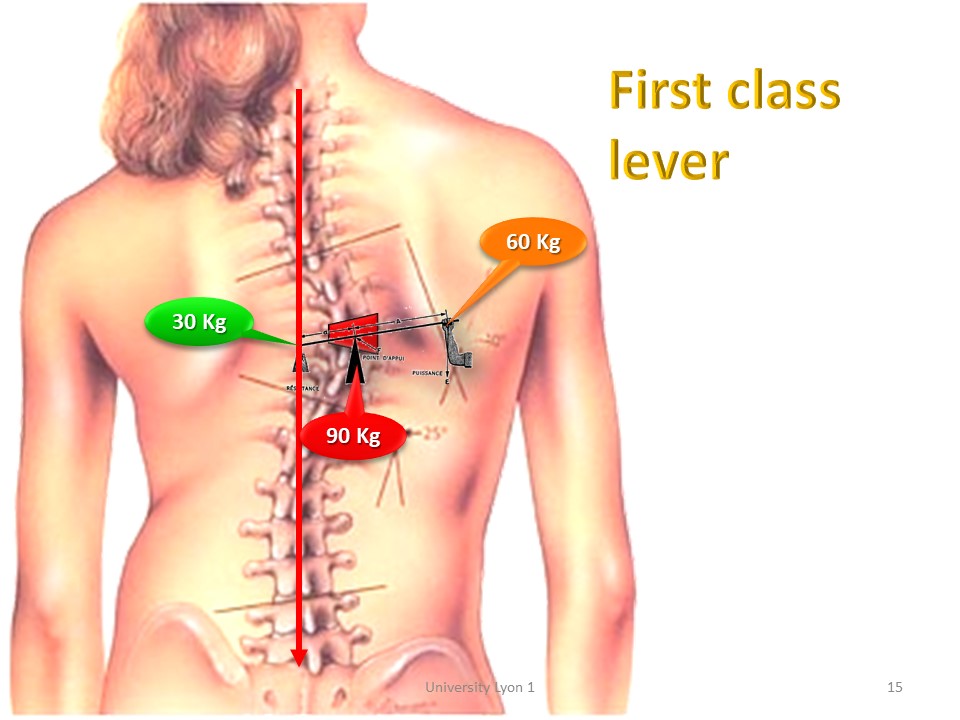 |
In fact, the more the apical vertebra moves away from the gravity line, the more the deforming load will be high at the concavity level. It is the result of a first-class lever arm.
|
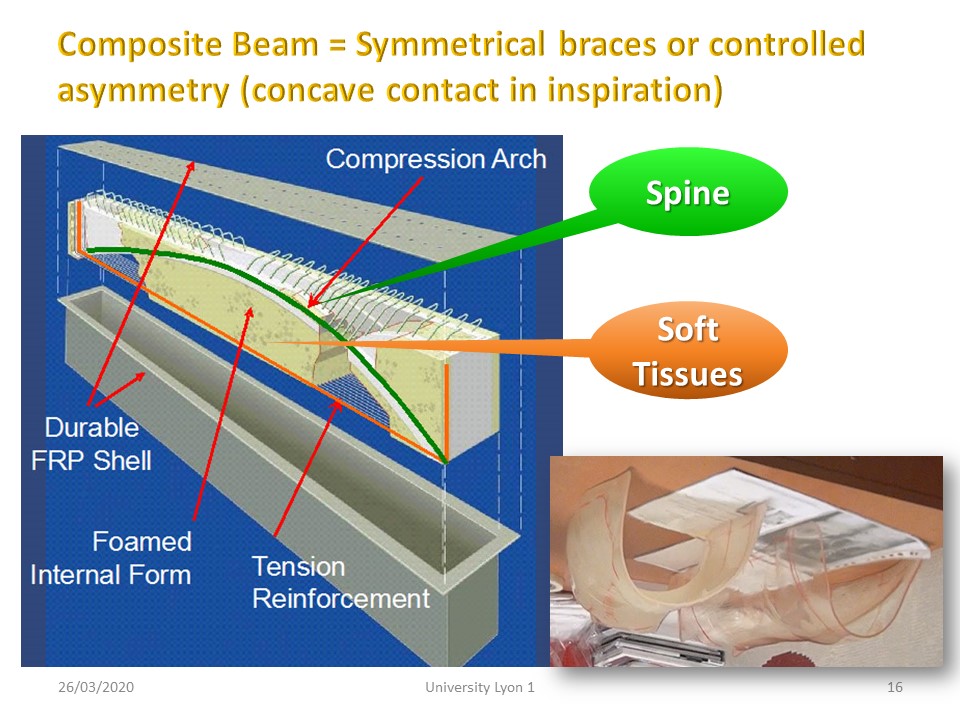 |
The brace acts as a composite beam with a very rigid outer shell strongly reducing the load at the vertebral axis. All symmetrical or slightly asymmetrical braces worn during the day are stopping the deformation of the apical vertebral body.
|
 |
Growth asymmetry with cuneiformization of the apical vertebra accentuates the vicious circle of scoliosis.
|
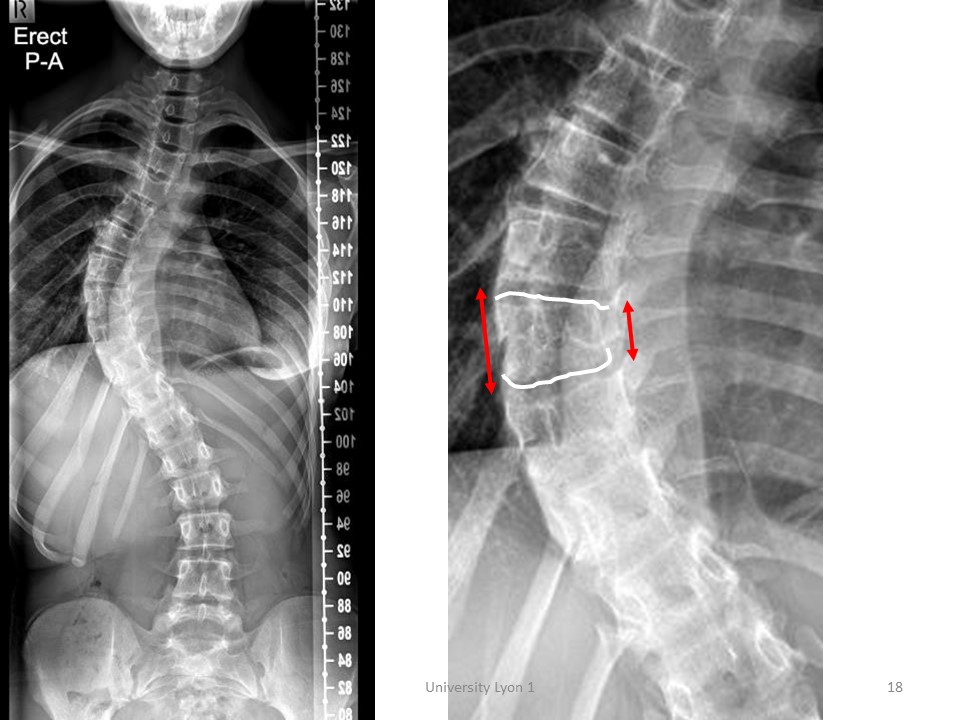 |
In addition to the vicious circle, the wedging of the apical vertebra explains the impossibility of completely reducing most of the scoliosis.
|
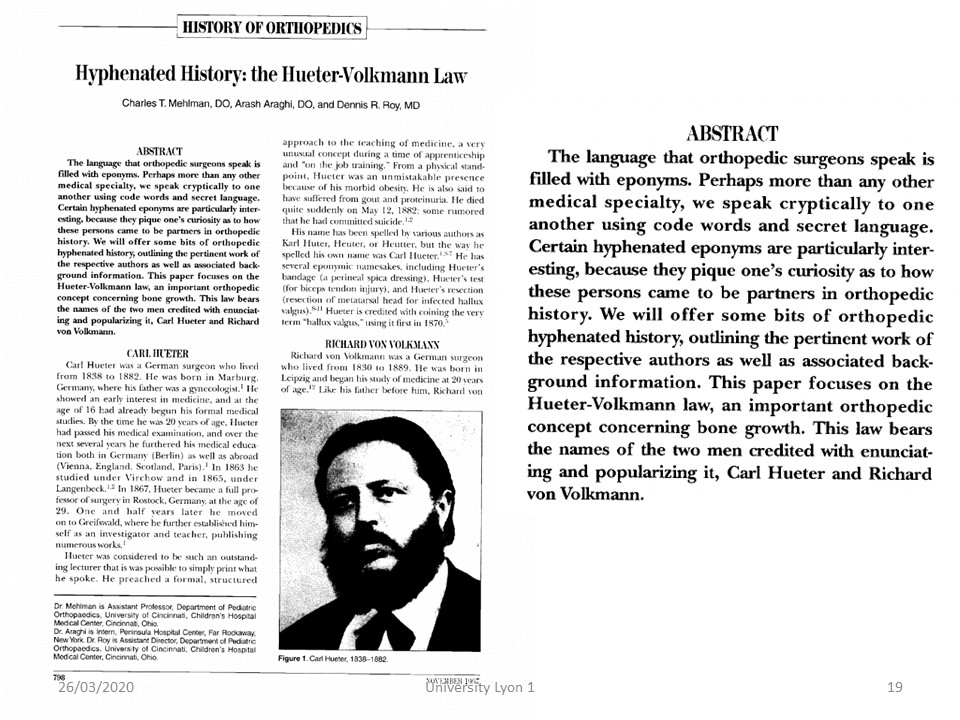 |
The Hueter-Volkmann’s laws of bone growth explain the decrease in growth at the level of the concavity, where the load is the strongest and the stimulation at the level of the convexity. |
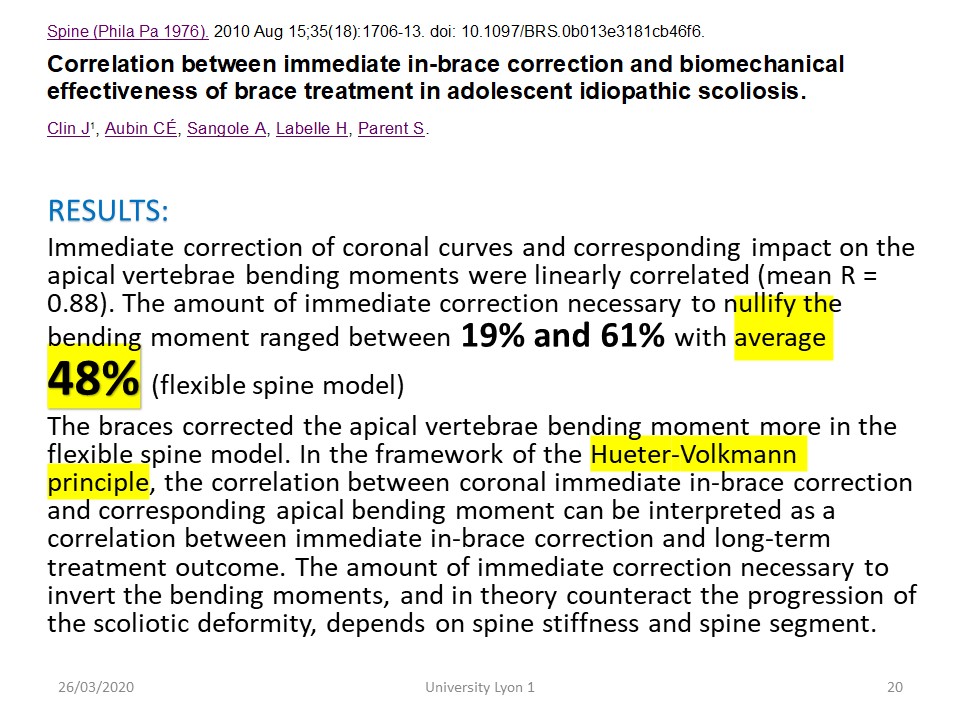 |
To reverse the load asymmetry, an average in-brace correction of 48% is required. Until now no brace has reached this average correction, (even the old Lyon brace). |
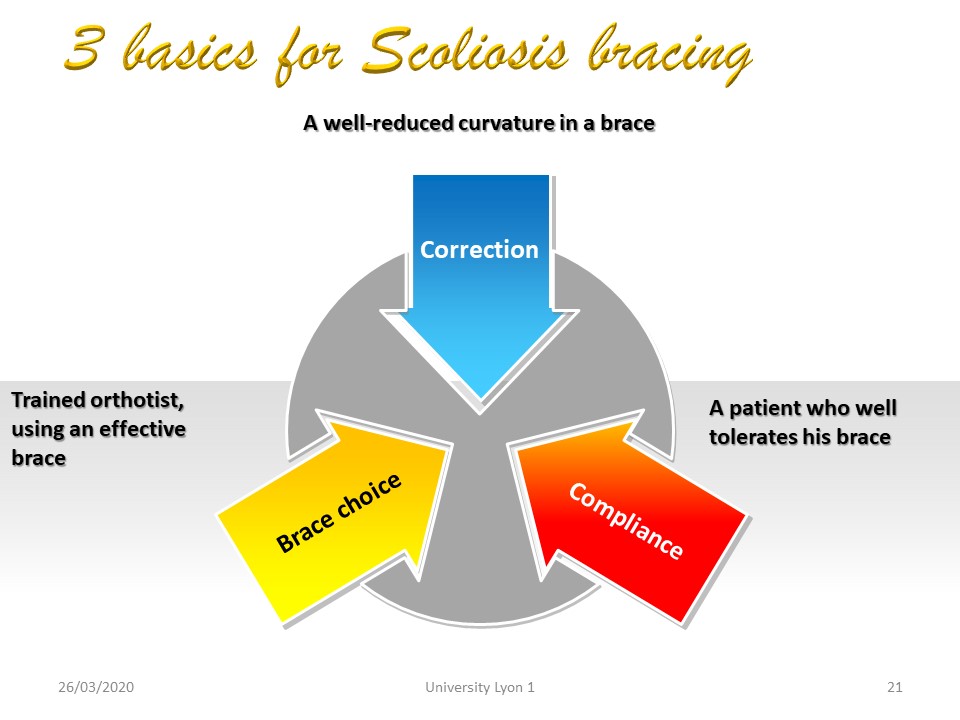 |
The good result of scoliosis bracing will depend on the type of scoliosis more or less reducible, the choice of the brace and the compliance of the child. We will now study the elements determining the choice of the brace. |
 |
The first element is the notion of team that for the first time can be translated into the realization of the brace. It was the doctor who was doing the plaster cast. It is desirable that it is the doctor or the physiotherapist who positions the patient for each of the three refional scans that constitute a digital cast. A specific program can be done by the physiotherapist to prepare the child. The orthothist who collects the 3 scanners will then perform the superposition according to a codified "processing". |
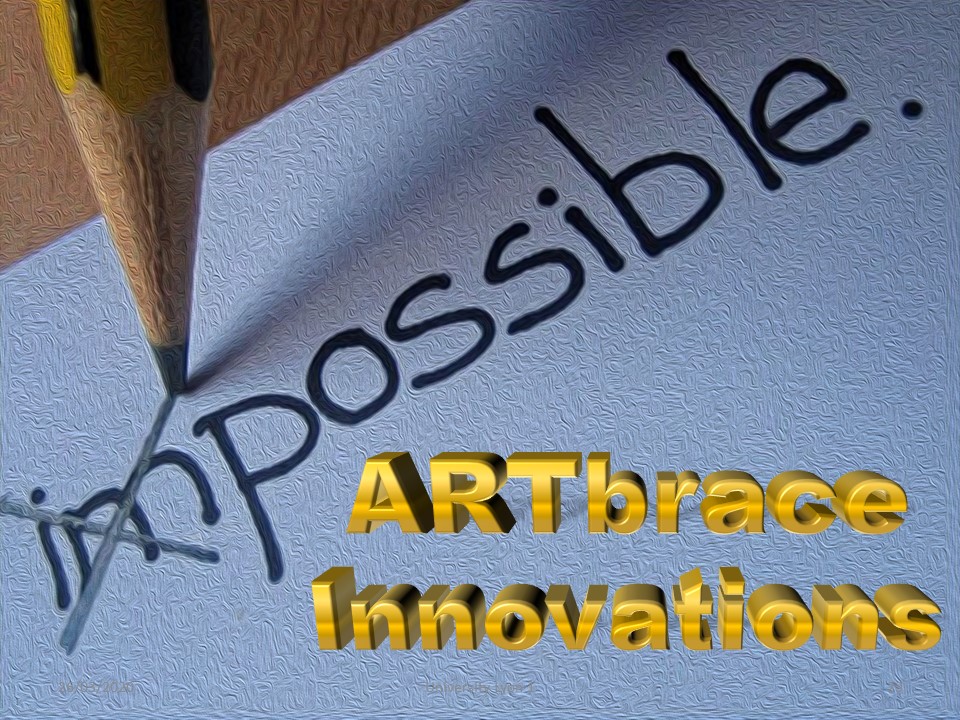 |
Most braces have undergone only minor evolutions during the last 50 years. The Lyon brace has been the subject of major innovations that we will study. The acronym ARTbrace was created by Stefano Negrini and, the main innovative features are in the acronym of ART 1. A stands for Asymmetry obtained with the digital cast 2. R stands for Rigidity (in fact Very High Rigidity) of polycarbonate 3. T stands for Torsion: the brace performing a Detorsion of the scoliotic Torso Column. which is a circled helicoid with horizontal generating circle in opposite direction of the spiral column while fixing the sagittal plane in a physiological position. This untwisting or detorsion is obtained by a regional correction by blocks in the sagittal and horizontal planes according to the law of the coupled movements. |
 |
Although older designs have proven effective (Weinstein 2013), the new concepts are able to improve the correction and tolerance of the brace which is a fundamental factor of compliance. We will detail besides Asymmetry, Rigidity and Detorsion: 4. ultra-simple classification. 5. the change of geometry with passage of the system 3 points to the geometry of the solids. 6. A new methodology: digital transformation with digital cast. |
 |
The new Lyon brace derives from previous braces. It combines high stiffness (HR), adjustability and asymmetry like Chêneau brace. |
 |
The protocol of indications and management is strictly superimposable to that of the old Lyon brace. It is therefore possible to compare the results of the 2 braces. Digital casting provides reliable, reproducible and efficient three-dimensional correction. The change of geometry improves the tolerance, the harmony and the balance of the curvatures. |
 |
It is the child himself who achieves asymmetry depending on the flexibility of the spine. Until now, the asymmetry was arbitrary and depended solely on the orthotist. Currently, this is a controlled asymmetry whose main principles are: 1. Surface asymmetry without internal pad. The child should slide into his brace as on a bobsleigh track in the opposite direction of scoliosis. ARTbrace is a dynamic brace 2. Alignment along the vertical axis of the spine. 3. Controlled asymmetry with concave contact in inspiration to respect the composite beam. |
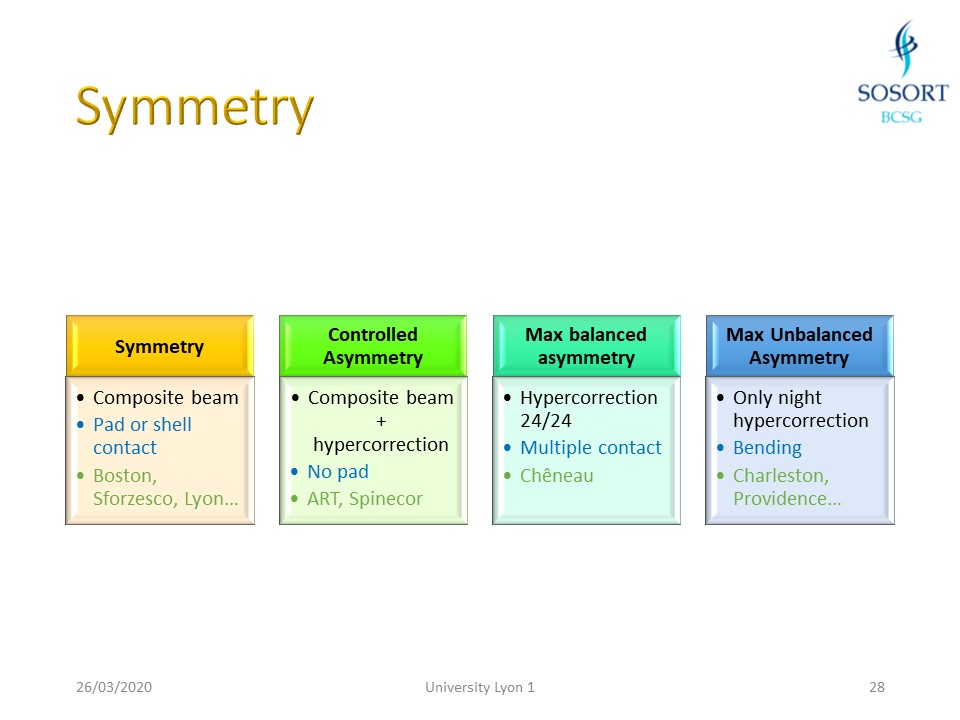 |
SOSORT BCSG has classified asymmetry into 4 categories: 1. Symmetrical braces like the Boston brace. 2. Controlled asymmetric braces like the ARTbrace we are studying. 3. Braces with maximum asymmetry : Chêneau like braces. 4. Night Asymmetrical braces with off-axis head, like Charleston brace. |
 |
The choice of braces is always difficult. There are many asymmetrical braces short or long. These are the most corrective for scoliosis between 25 ° and 40 °. |
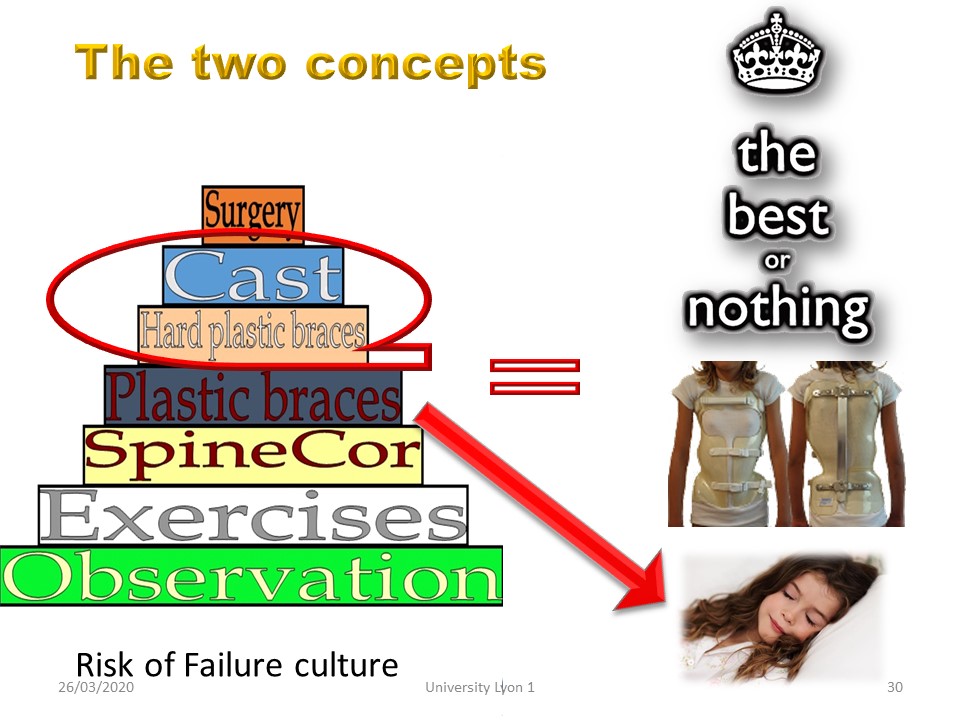 |
The concept of step by step with the progressive use of increasingly effective braces according to the progression of the curvature can be considered as a culture of failure especially since the most traumatic for the child is the fact of wearing a brace whatever the type of brace. We believe that even small curves are entitled to the most effective brace and that it is the wearing time that must adapt according to the angulation, age and progression of the scoliosis. |
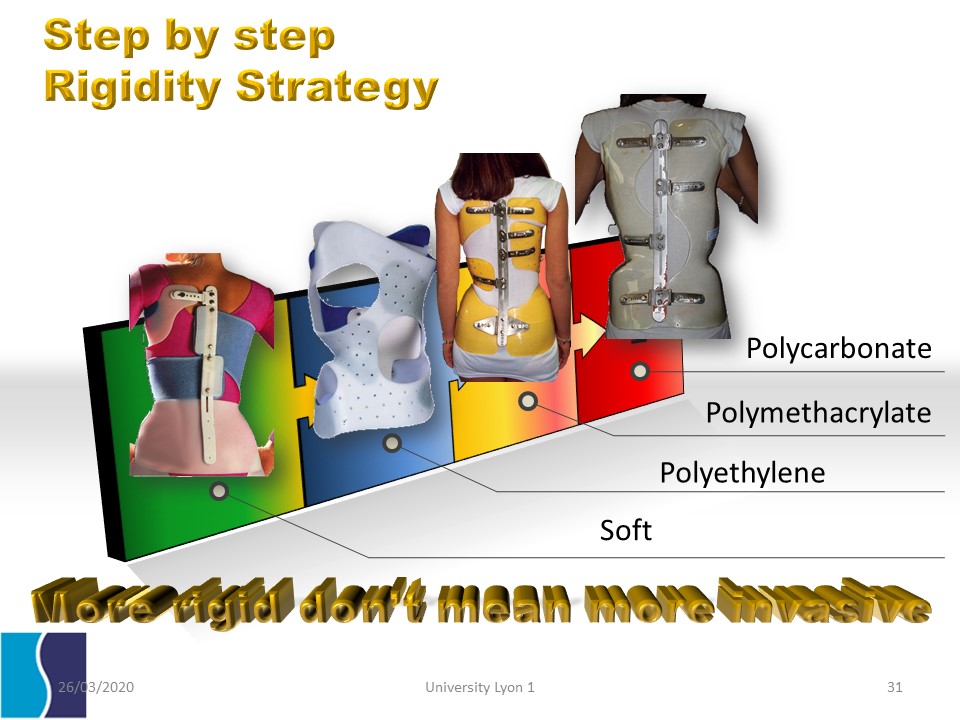 |
Especially since polyamide is usually better tolerated than polyethylene. |
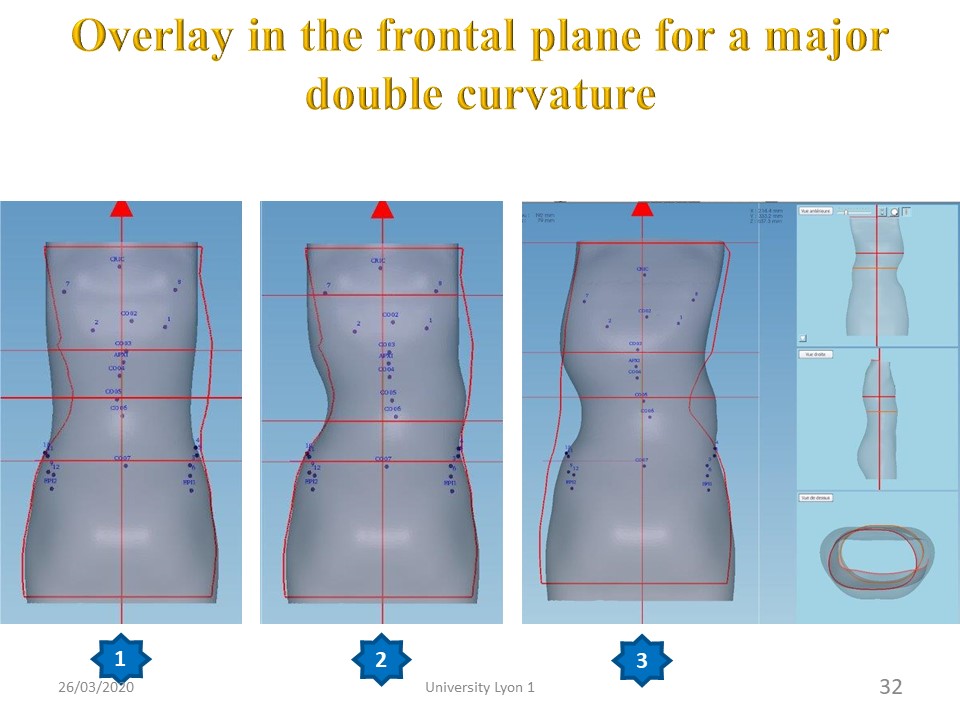 |
Asymmetry is obtained by superposition of the 3 digital cast scans. Picture 1, on the left. In gray the initial molding n ° 1 and, in red the molding n ° 2 with lumbar shift. Picture 2, in the middle. In grey, modification of the lumbar region with a specific software. Picture 3, on the right. In red the molding n ° 3 with thoracic bending. Reshaping of the thoracic region. The scapular girdle will then be superimposed to reconstitute a vertical and symmetrical under arm. |
 |
The “axilla baby lift concept” is characteristic of ARTbrace. It can be compared to the manual grip of a child that is lifted under the arms. The scapular girdle constitutes a fixed point. |
 |
In case of high thoracic curve, you can tilt the axillary wrench with rotation on the sagittal axis to correct and rebalance shoulders. |
 |
The same procedure is applied in the sagittal plane. On the left of the picture: in red, the molding n ° 1 in hypolordosis and in gray the lumbar correction with molding n ° 2 in physiological lordosis, On the right of the picture: in gray the final brace with correction of the thoracic flat-back with, in red the molding n ° 3 in physiological kyphosis. All these procedures are performed using a professional software, allowing changes with constant volume. |
 |
The corrections made are accurate to 1 mm, but the shape of the trunk will change with growth. The outer shape of the brace represents a torso column in the opposite direction of the scoliosis, in which the child slides, the brace adjustments allow to remain effective during 7 cm of growth in size. This is one of the advantages of solid geometry compared to the 3-point system of plane geometry. |
 |
Asymmetry is a fundamental factor of in-brace correction for curvatures of less than 40 °. The goals of bracing can become more ambitious, especially since the major psychological impact of bracing is the fact of prescribing a brace. The fact that the brace is very or slightly corrector does not modify the impact. |
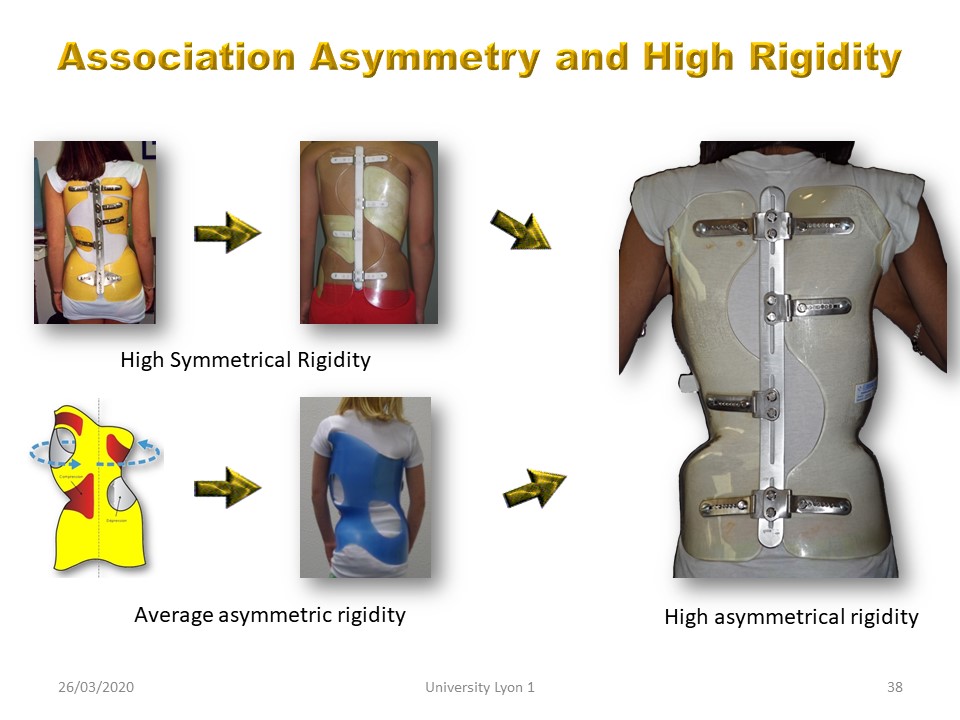 |
When we associate rigidity with asymmetry, precision becomes a fundamental factor. Polycarbonate does not have the tolerance of polyethylene and a precision of 1 mm is necessary during the acquisition and processing of the 3 scanners. By comparison the accuracy of the Ipad is plus or minus 7 mm ,not counting the time required for the measurement. |
 |
High rigidity has proved its effectiveness with the Lyon brace. However, it did not allow replacing the plaster cast for the most important curvatures. Even if the old Lyon brace in polymethacrylate was very rigid, the credit for VERY HIGH RIGIDITY goes to the Italian team of ISICO with the Sforzesco brace, which has proven to be effective by avoiding plaster casts for scoliosis over 45°. The merit of the ART brace is the addition of overcorrection to the high rigidity with a global detorsion. It is this asymmetry for small curvatures which explains the average improvement of the in-brace correction. |
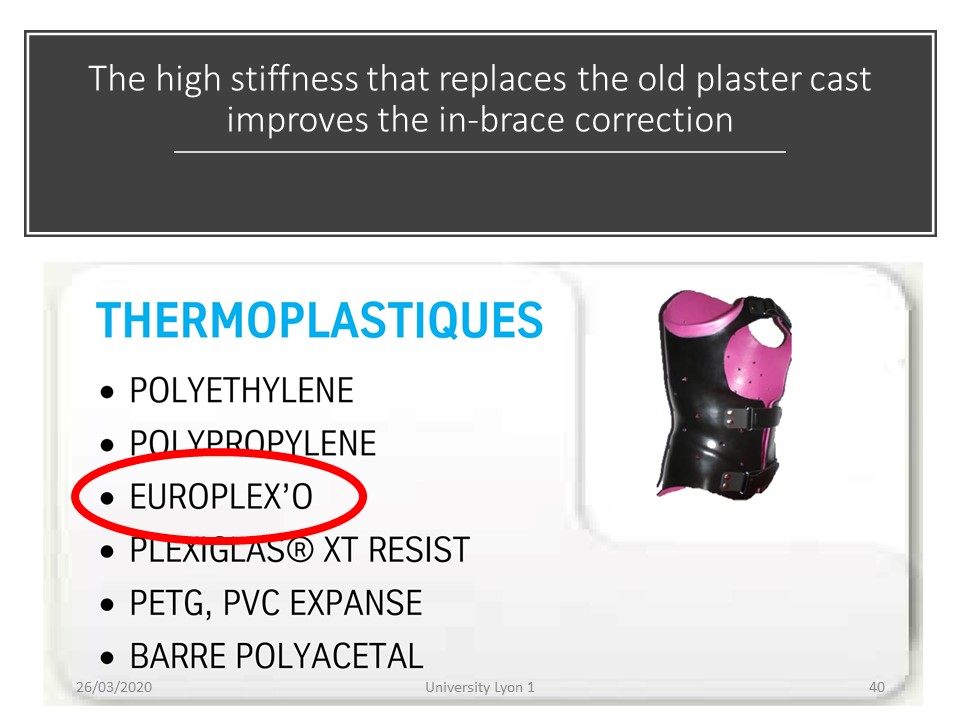 |
The high-rigidity thermoplastic currently used is Europlex 'O or Polyamide 6, the advantages of which we will see. |
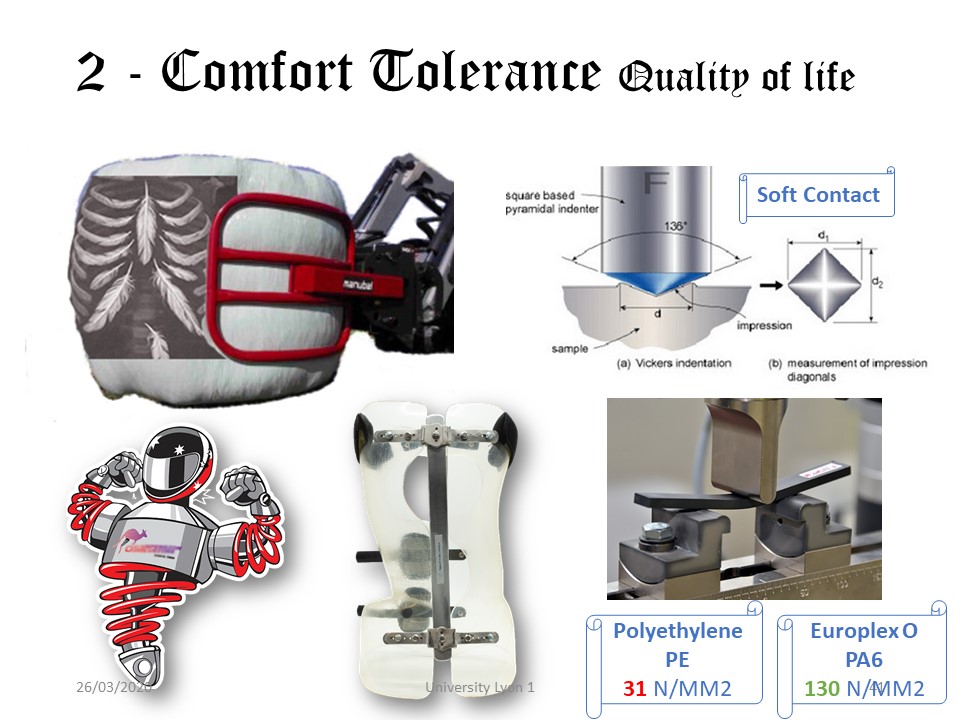 |
The rigidity of the Europlex is 130 newtons per square millimeter. Whereas for the same thickness of 4 mm polyéthylene, the rigidity is only 30 Newtons per square millimeter. On the other hand, contact with the skin is soft, the polyamide is not hard and, on the contrary, constitutes a shock absorber.
|
 |
SOSORT BCSG has specified the rigidity criteria that depend on the thickness of the plastic. This is why other simple criteria have been chosen. 1. Tissue. The contact is permanent with the skin. 2. Rigidity with intermittent contact areas. 3. Overall rigidity, allowing opening for fitting. 4. High rigidity. Opening is done as a book with hinges on a posterior metal bar.
|
 |
The very high rigidity of the polycarbonate makes it impossible to deform in the frontal plane and in the sagittal plane. In the frontal plane, the only mobility is in the expansions. In the sagittal plane, there is no mobility, apart from anterior abdominal expansion. In the horizontal plane, shearing and derotation are possible depending on the metal-polycarbonate deformation of the posterior bar assembly and hinges.
|
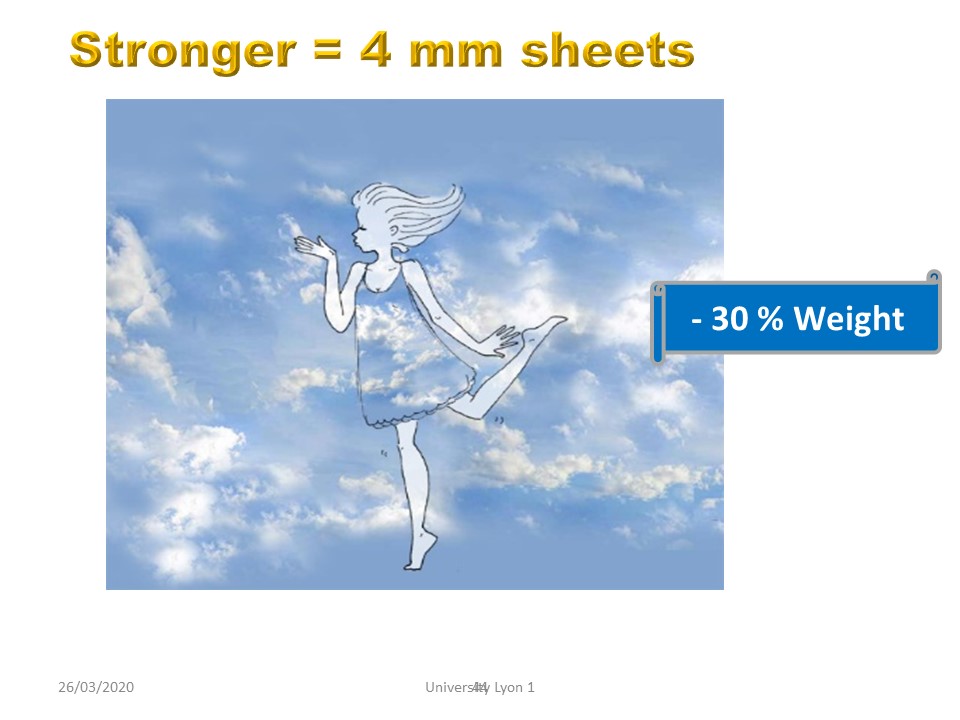 |
Polycarbonate is much lighter, (1/3) than other plastics, which is a benefit for the child and for aesthetics.
|
 |
Polycarbonate is more insulating than glass, which is why it is often used for verandas. The child sweats less.
|
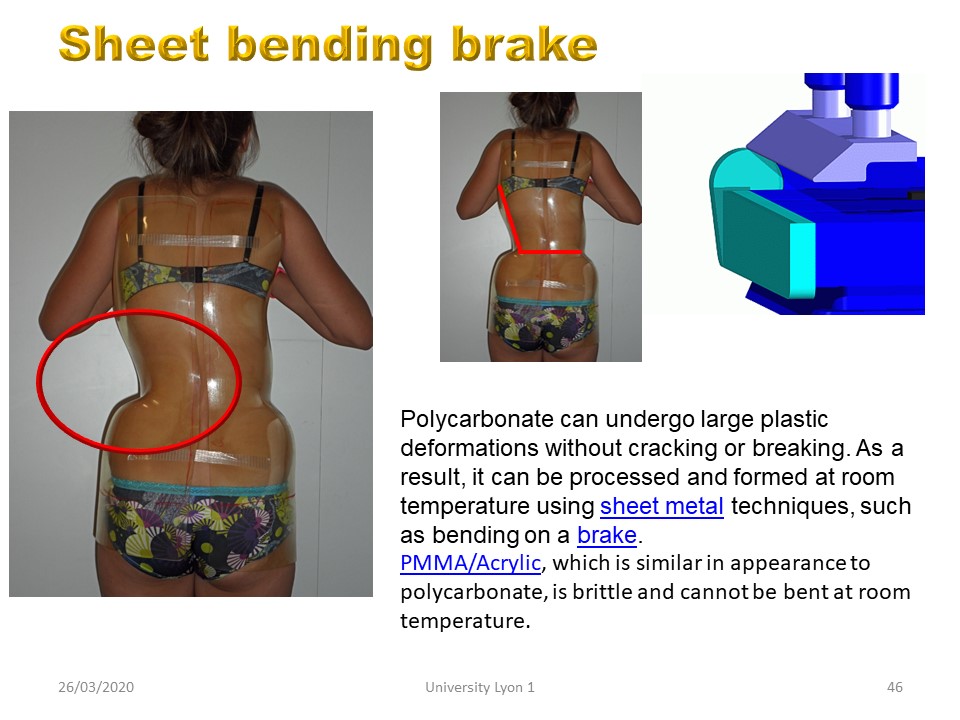 |
The advantage of the Europlex is the ability to bend over 90 °, which allows the easy realization of the convex iliac plateau, and a real translation of the lumbar spine towards the line of gravity.
|
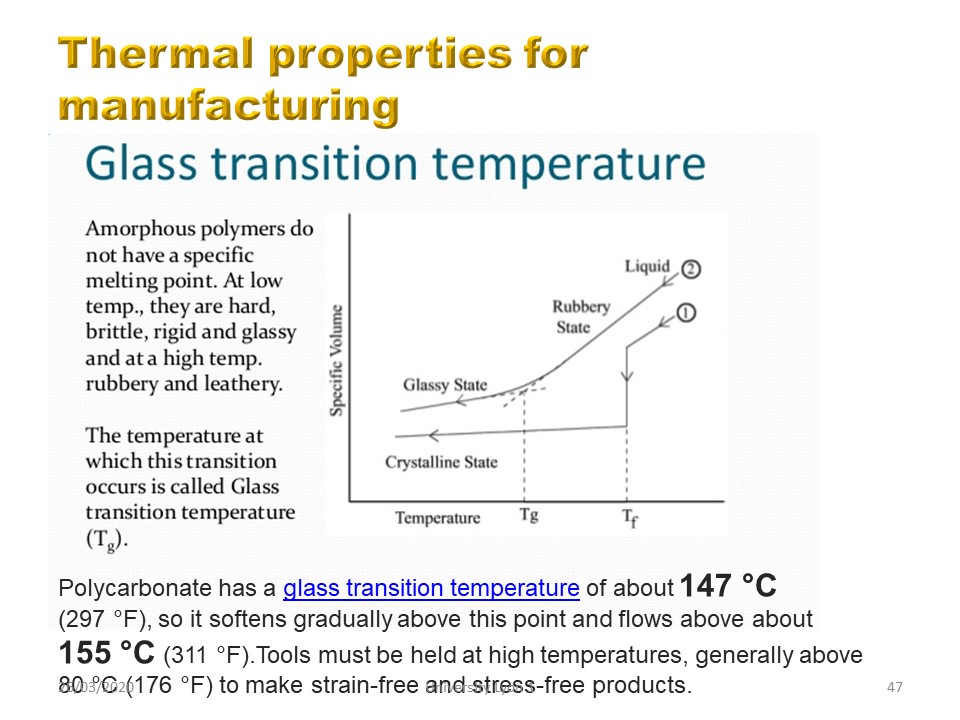 |
The major difference with other plastics is the very precise glass transition temperature, which requires thermoforming near the oven and a constant temperature in the thermoforming room. Polycarbonate has a glass transition temperature of about 147 °C (297 °F), so it softens gradually above this point and flows above about 155 °C (311 °F).Tools must be held at high temperatures, generally above 80 °C (176 °F) to make strain-free and stress-free products.
|
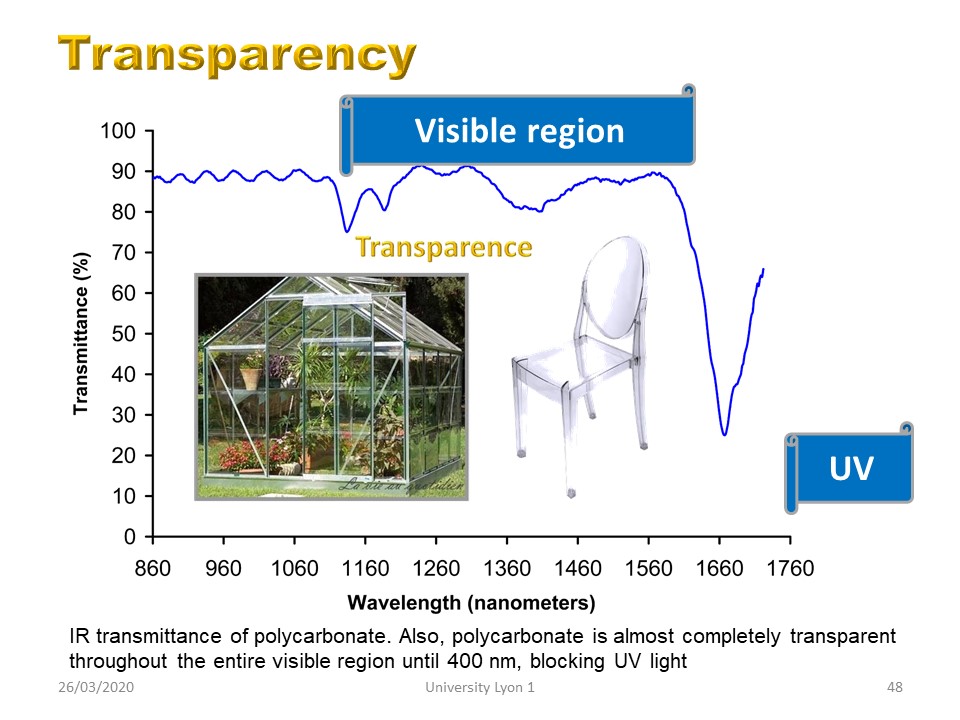 |
Also, Europlex’O is almost completely transparent throughout the entire visible region until 400 nm, but blocking UV light. The transparency of the brace is a priority wish in children and a major psychological element.
|
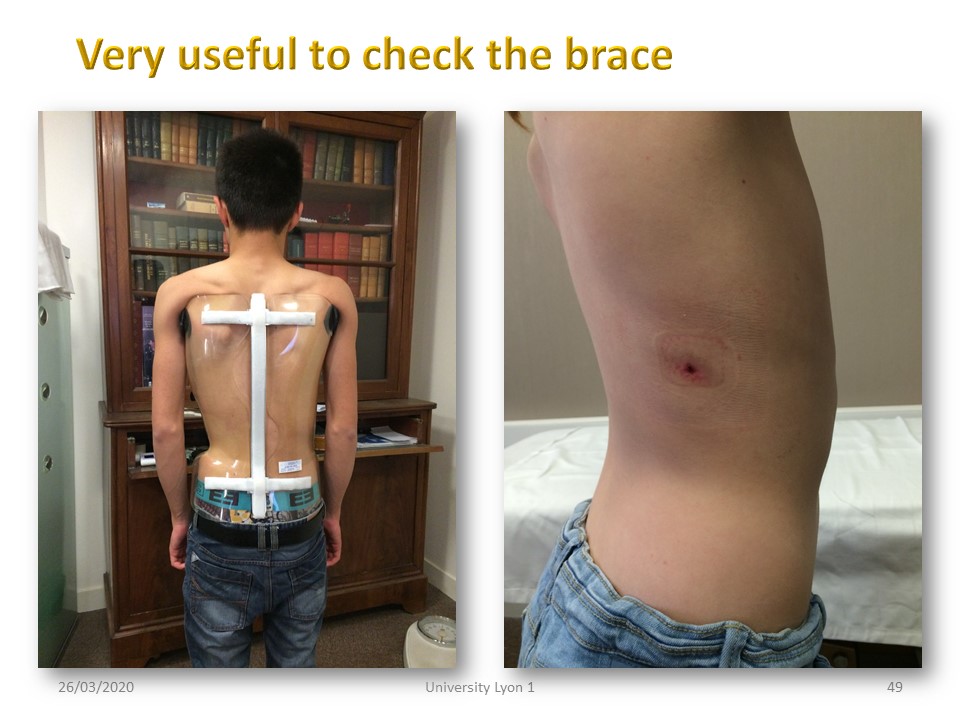 |
Transparency is also useful for the doctor who, in case of skin problems can control the contact area. Bursitis is rare and usually disappears spontaneously in 3 weeks. The application of talcum powder on the skin is then emphasized to facilitate sliding.
|
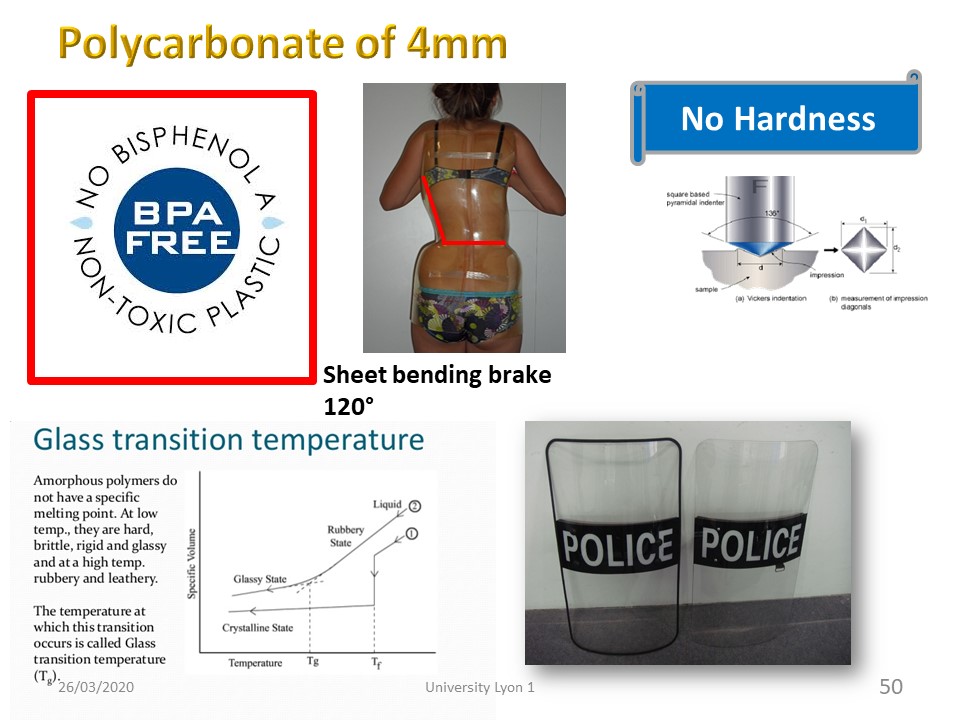 |
Professional polycarbonate (Europlex, for example) does not contain bisphenol A.
|
  |
A 3-point system works in a plane. It is impossible to reconstruct or modify a volume from one or even several planes. Detorsion is the main feature of ARTbrace. We have seen in the 3D module the law of coupled movements, we will take again the elements more specific to ARTbrace.
|
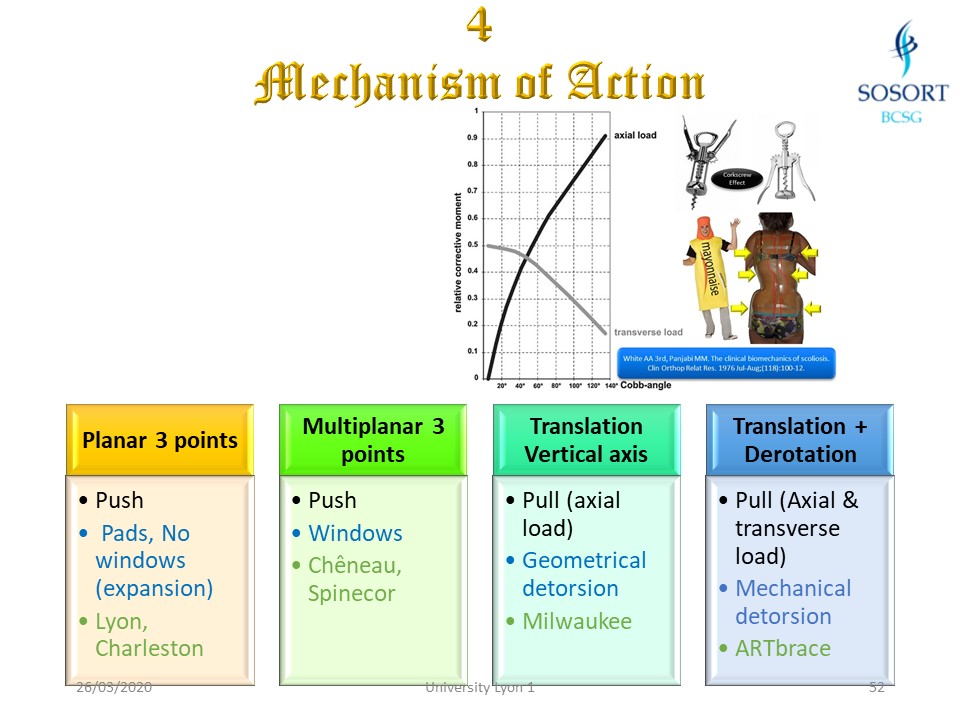 |
There are different mechanisms of action to correct scoliosis. The most common system is the 3-point system in the plane of the apical vertebra. Some braces multiply the planes but always with contact zones and expansion zones. Some braces such as the Milwaukee carry out a global detorsion by translation along the vertical axis (geometric detorsion). The ARTbrace combines geometric and mechanical detorsion.
|
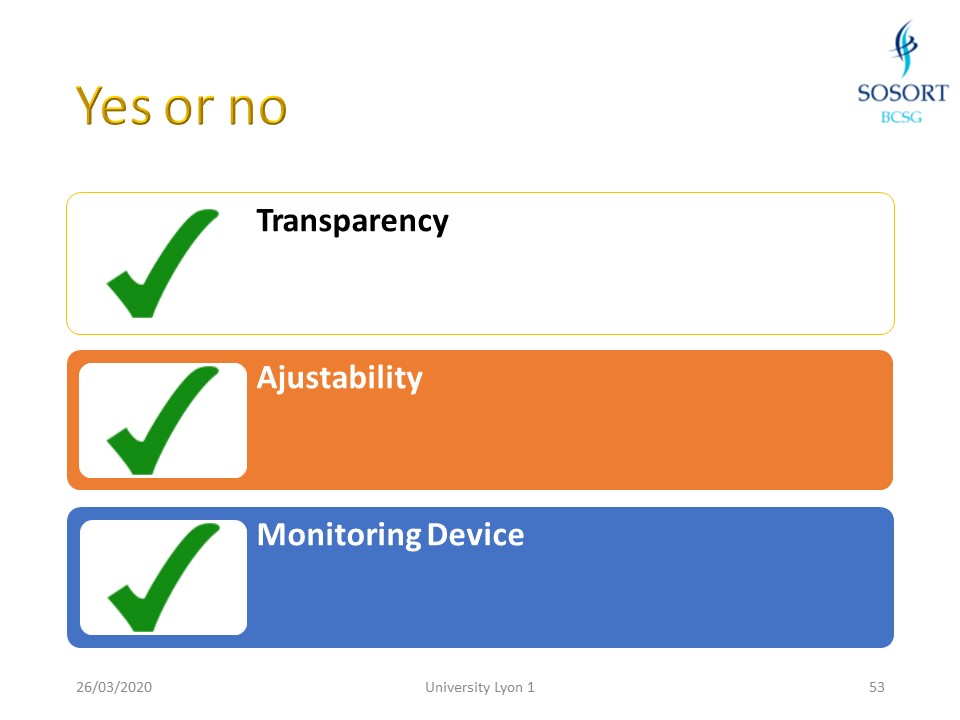 |
Other elements must be considered: transparency, the possibility of adjustment with growth, the existence of a monitoring system to assess compliance.
|
 |
The detorsion requires two fixed points at both ends of the curvature and an intermediate twisting motion. The ARTbrace is the only brace with under-arm stabilization. Two geometric and mechanical mechanisms will favor this untwisting. We are moving from plane geometry to solid geometry.
|
 |
The detorsion is carried out according to the mechanism of the key and the bolt. For a single thoraco-lumbar curvature: the pelvis is blocked by the key of 13. The head of the bolt is stabilized at the level of the under-arm. The adjustable wrench at the thoraco-lumbar hinge performs the detorsion.
|
 |
The first mechanism of the geometric detorsion is the translation along the vertical axis by elongating the two ends of the torso column.
|
 |
White and Panjabi published in 1976 the action of the forces necessary for the correction of scoliosis according to the angulation. For an angulation of less than 40 °, the frontal forces are the most corrective. When the angulation exceeds 40 °, the translation along the vertical axis becomes the most effective.
|
 |
The ARTbrace combines the two mechanisms.The average immediate height gain in brace at the time of fitting is 1.5 cm.
|
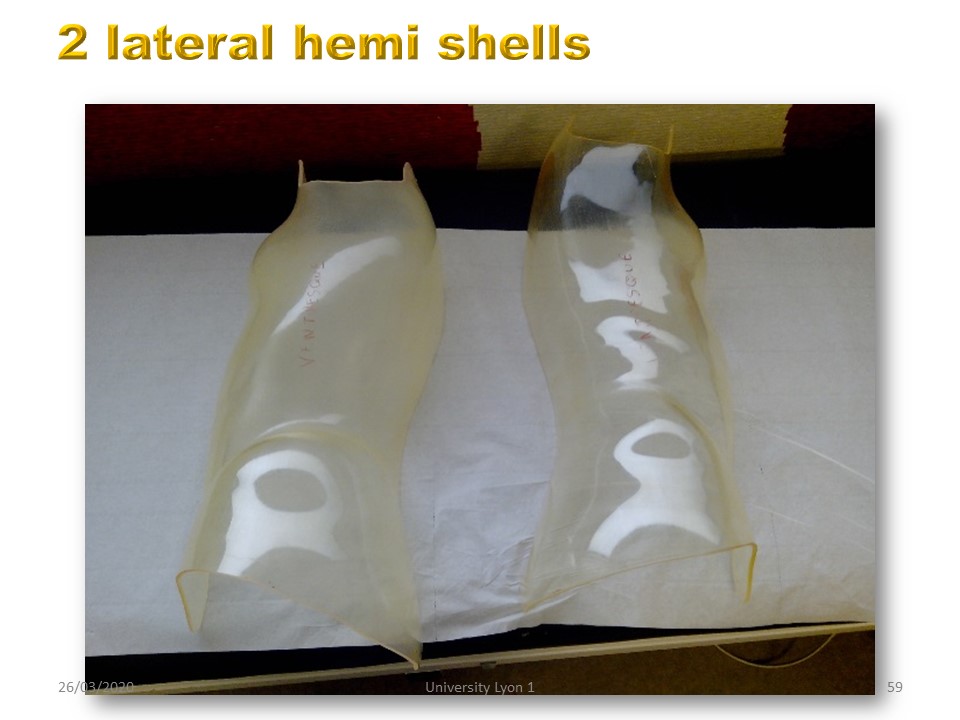 |
The under-arm trim line is maximum at the time of brace fitting. The child has high shoulders, but very quickly, the shoulders will have a tendency to go down again, which will further untangle the spine. |
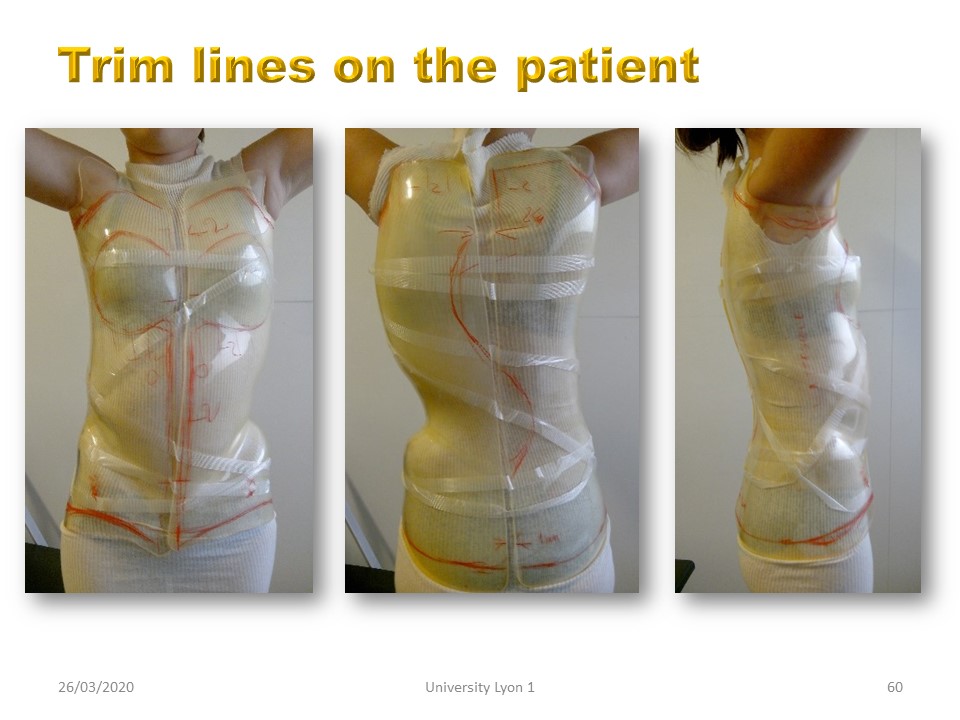 |
The 2 hemi-valves are gradually approximated with adhesive. The standing position allows a good balance of the occipital axis. Low trim-lines should facilitate the sitting position. The posterior high trim lines aims at favoring the thoracic kyphosis and the rolling of the shoulders in case of flat back. |
 |
The trim-lines are drawn on the brace before cutting. The transparency of the polycarbonate facilitates the exact positioning, indeed the skin draws contours according to the applied load. |
 |
This effect of axial elongation by bringing the two lateral hemi-valves closer together is the mayonnaise tube effect. |
 |
This tube effect mayonnaise continues and often 6 months after the fitting, tightening has increased a few cm, testifying to the detorsion. |
 |
The thoraco-lumbar hinge is strategic because it is at this level that the spiral chains intersect. The tightening at the base of the rib cage is the most important. The rack and pinion closure allows a very precise adjustment. The closer the brace is, the more the child will grow up and the under arm area will be cleared. |
 |
The transverse linking of the 2 lateral hemi-pieces helps to globalize the shape of the thorax, which is often flattened in scoliosis. |
 |
The second mechanism is the mechanical detorsion which is carried by the entire external surface of the thorax. The brace will correct the thoracic and pelvic deformity, but especially move the volumes. The faces of the solid obtained from the cutting planes are called bases of the trunk, and the distance between the two cutting planes is the height of the trunk. The lateral surfaces of this solid are not necessarily planar, but are hyperbolic paraboloids.
|
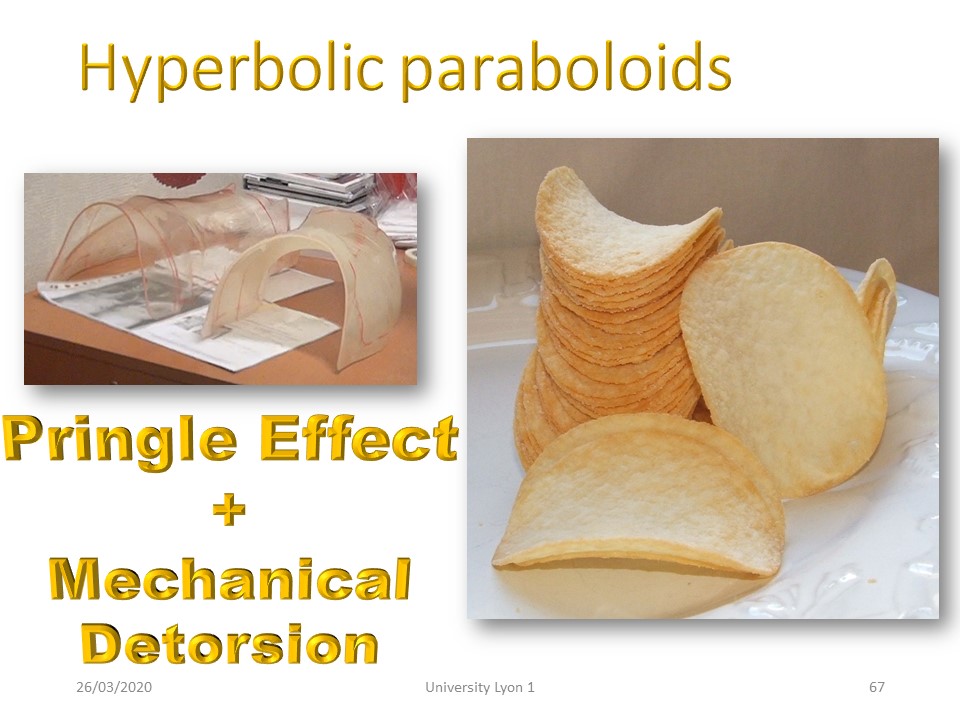 |
>The two hemi-pieces of ART are indeed hyperbolic paraboloids adding "Pringle effect" and mechanical detorsion obtained by the geometrical detorsion.
|
 |
In scoliosis, it is not only the vertebral axis that is deflected and deformed, but the pelvis, the waist, the rib cage, and the scapular girdle. The surgery acts only on the vertebral axis, the conservative treatment acts on the whole trunk. It is through the outer surface of the trunk that the mechanical detorsion is performed. The consequence is a "soft touch" like the clamp that handled the bales of hay covered with a thin film of plastic wrap without tearing them.
|
 |
When all the corrections have been made on the surface of the brace, it is no longer necessary to use the internal pads. The child finds himself as in a bobsleigh track opposite to scoliosis. It is therefore a dynamic structure with a contact that will be different depending on the positions adopted by the patient. |
 |
Unlike the Chêneau brace, there is no lumbar expansion in the ARTbrace. The dynamic action achieving a "push up" effect as in the Sforzesco brace. |
 |
This "push up" effect is obtained during processing by reducing the volume at the concavity level. |
 |
The advantage is to correct the lumbar curvature as well as possible, while having better contact at the level of the lower ribs of the thoracic convexity. |
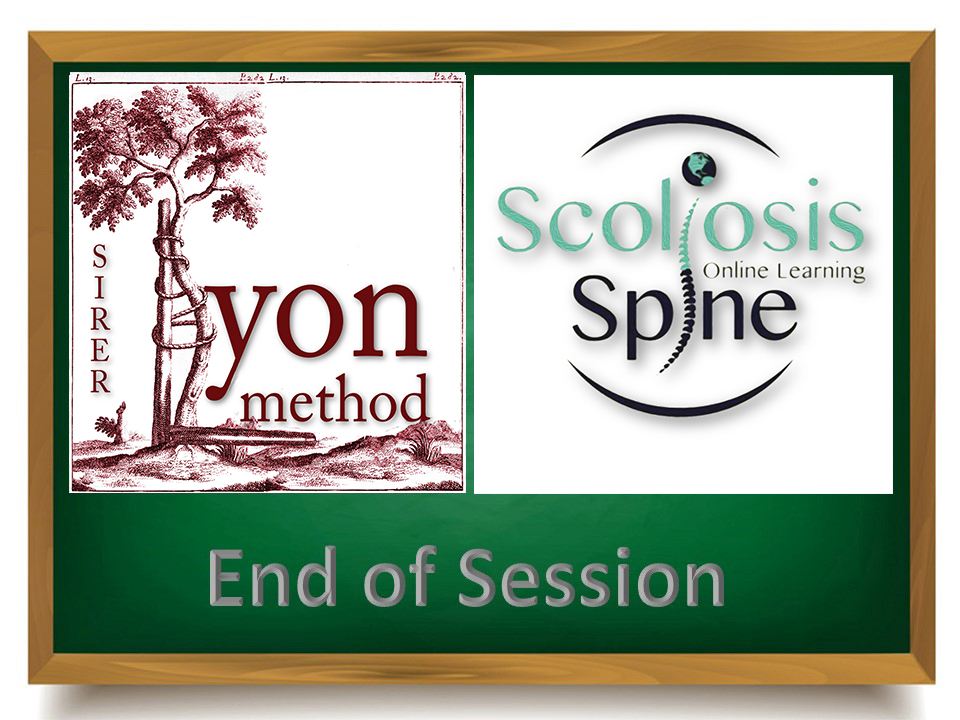 |

To register for Certification, please contact SSOL

|